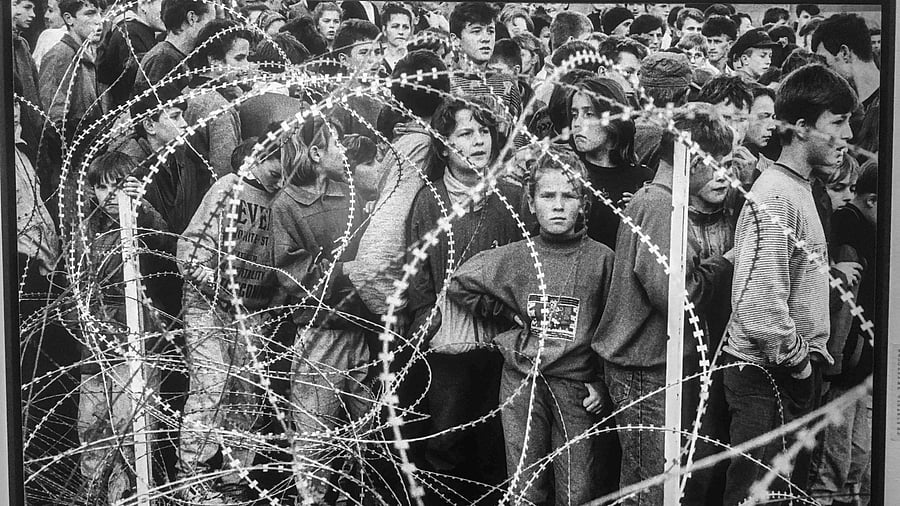
One of Salgado's iconic clicks. (Pic courtesy: Wikimedia)
When the Brazilian photojournalist and environmentalist Sebastião Salgado passed away at the age of 81 in Paris in May this year, there was a profound outpouring of grief. Salgado’s death reportedly was caused by leukaemia, which was triggered by malaria that he contracted during a project in Indonesian New Guinea way back in 2010.
“The world has lost a giant,” said Pulitzer Prize-winning photographer David Carl Turnley. “His life’s work and photographs will live forever.” David’s twin brother, Peter Turnley, also a renowned photographer, said: “Few people in my lifetime have touched the world so profoundly with their images as Sebastião!” Shahidul Alam, the brave Bangladeshi photographer who is constantly challenged physically, politically and creatively by an authoritarian regime, wrote a heartfelt poem: “The world has lost a man of magic—/ A man with a healer’s hands and a seer’s eye … / I won’t say rest in peace,/ Because his soul was always at peace …”
German filmmaker Wim Wenders believed in Salgado’s death, the world had ‘not only lost a unique photographer and artist, but also an ambassador for responsibility and humanity and an avowed environmental activist.’
Born in 1944 in Aimorés, a small town in the Brazilian state of Minas Gerais, Salgado studied economics at São Paulo University and earned a Master’s degree in 1968. Seen as a political radical by Brazil’s military government, he was exiled in August 1969. He and his wife Lélia Wanick Salgado fled to France, where he continued his studies and earned a PhD in economics from the University of Paris in 1971. Thereafter, he dedicated himself to photography, initially taking freelance jobs with photo agencies Sygma and Gamma, to cover stories in Africa, Europe, and Latin America. In 1979, he joined the influential Magnum Photos, a turning point in his illustrious career. After a 15-year association with Magnum, he and his wife established their own agency, Amazona Images. In 1998, the couple co-founded Instituto Terra, a nonprofit environmental organisation dedicated to the sustainable development of the Valley of the River Doce in Brazil. The organisation went on to facilitate an ecological regeneration and reforestation programme covering 17,000 acres of Atlantic Forest in Minas Gerais.
Powerful storytelling
As a distinguished photographer, Salgado developed a unique and instantly recognisable style that focused on powerful, human-centred storytelling. He dedicated his life to black-and-white imagery and dramatic lighting. Instead of stand-alone pictures, Salgado preferred to do a series of photographs on specific topics and locations. Throughout his career, he travelled to all corners of the globe, covering 120 countries and capturing the stark realities of humanity as well as the breathtaking beauty of the natural world. His stunning monochrome images showcased the varying tones of human suffering, as well as the agony and ecstasy of life, and the resilience of many indigenous communities. He documented both the mysterious and the mundane, portrayed pristine environments as well as those in decline, with deep love, respect, and understanding. His photographs addressed hard-hitting social themes while maintaining a sense of poetry and rhythm, even in settings marked by pain and adversity.
Salgado’s 1993 exhibition, In Human Effort, at the Tokyo National Museum of Modern Art, was a landmark retrospective. Since then, his pictures have been exhibited in numerous shows and multiple locations around the world. For his pathbreaking work, Salgado received numerous international prizes.
While receiving praise for his extensive photographic work, Salgado also faced criticism from some quarters. Several voices accused Salgado of objectifying, and in some instances, sexualising and eroticising Indigenous subjects. His frequent depiction of women and children in full or partial nakedness attracted significant criticism. American writer Susan Sontag was an especially strong critic.
Despite the criticism, Sebastião Salgado’s legacy remains unparalleled. His work displayed an artistry that contemporary photographers would find difficult to replicate.